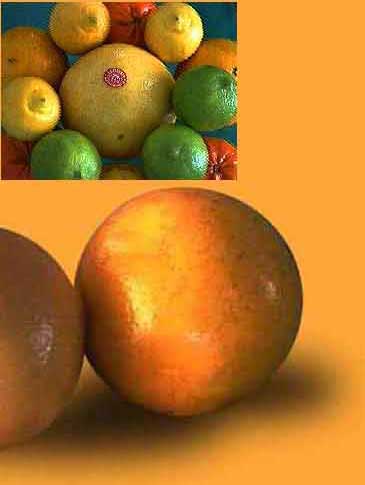| Story by Helen Hill Photos by Barbara Bose Florida Citrus Growers More Absolutely Florida Florida is the #1 state in the US for growing oranges. It is #2 in the world after Brazil. 95% of Florida oranges goes for processing. According to Florida Agricultural Statistics Service (Florida Dept. of Agriculture.) In the 1998-99 season Florida citrus farmers expect to produce 190 million (90-pound) boxes of oranges. Due to El Nino and several storms etc. the crop is down from a bumper 1997-98 season when 244 million boxes of oranges were produced. (California = 74 million boxes) Florida is a major producer in US of fresh and processed grapefruit. It accounts for more than third of world grapefruit production. Half
the Florida crop is sold as fresh fruit and half goes for processing
In the 1997-98 season Florida produced 49.6 million boxes (California
= 9 million. Texas and Arizona = 5 million boxes).
|

Many of the groves have given way to high-rise apartments and shopping malls but the sweet scent of orange blossom still wafts through the air in spring. In winter, parts of Orange county live up to its name with groves of golden fruit nestling against dark green leaves to feast the eye -- and the taste buds. Now
we take it for granted that we can enjoy fresh tree-ripened citrus Only people living near the groves could buy fruit when citrus growing got underway in Florida a hundred and fifty years ago. Shipping citrus north involved a tedious journey, first loaded on horse-drawn wagons and then carried by barge up the Ocklawaha River to the St. John's River where it was reloaded onto steamboats. The boats sailed up the Atlantic coast delivering fruit to ports along the way as far as New York where fresh Florida oranges were a luxury. The demand for citrus increased each year but the fruit could not reach northern markets quickly enough. The
railroad offered the answer. Onc Growers were doing well until one of Florida's notorious killer freezes devastated the citrus crop in the 1890s. A series of freezes over the years wiped out many citrus groves forcing commercial growers to give up or move further south. Although the freezes wiped out many growers, orange juice still ran in their families's veins. When they were no longer able to grow citrus, several pioneer families switched to shipping gift fruit. Families of three or four generations now concentrate on sending a taste of Florida sunshine countrywide in the form of baskets of luscious oranges, grapefruit and tangerines. Indian River Citrus Museum, at 2140 14th Avenue in Vero Beach, is dedicated to the history of the citrus industry from the late 1800s to the present. After strolling through a small grove to hear about the varieties of fruits there, visitors can stop off at the gift shop to buy unique citrus-themed gift items and fresh citrus (in season).
Citrus County in northwestern Florida, was named for its shady groves of citrus. Today it no longer rates as a center for the citrus industry. Apart from hardier types of citrus such as satsumas and kumquats which can be grown in northern Florida, the heart of citrus growing is centered in Polk County and south. (See map) The Indian River region on the east coast of Florida gives its name to some of the most delectable grapefruit grown anywhere The Gulf Coast around Lakeland is another major citrus area. New groves are being planted in the Glades area around Lake Okeechobee. Florida citrus varieties range from grapefruit, oranges, tangerines, tangelos, mandarins to lemons, limes and kumquats. Florida only produces a small amount of lemons. It grows most of the limes in the US but total production is not very large
|
||||||||
<
 Mouse
and friends moved into Central Florida the area was known as a source
of pleasure of the juicy kind. Back then, Orlando was a sleepy town
ringed with sparkling lakes, pine forests and citrus groves, located
where else, but in Orange County.
Mouse
and friends moved into Central Florida the area was known as a source
of pleasure of the juicy kind. Back then, Orlando was a sleepy town
ringed with sparkling lakes, pine forests and citrus groves, located
where else, but in Orange County. thousands of miles away from Florida, but it wasn't always that
easy.
thousands of miles away from Florida, but it wasn't always that
easy. e
the tracks were extended to the western side of Orange Lake, freight
trains carried crates of citrus north in a matter of days.
e
the tracks were extended to the western side of Orange Lake, freight
trains carried crates of citrus north in a matter of days.